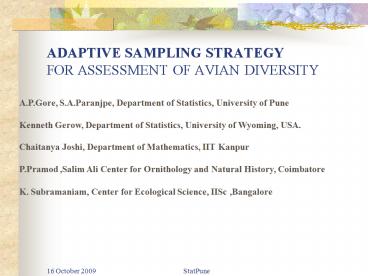ADAPTIVE SAMPLING STRATEGY FOR ASSESSMENT OF AVIAN DIVERSITY - PowerPoint PPT Presentation
1 / 14
Title:
ADAPTIVE SAMPLING STRATEGY FOR ASSESSMENT OF AVIAN DIVERSITY
Description:
Kenneth Gerow, Department of Statistics, University of Wyoming, USA. ... P.Pramod ,Salim Ali Center for Ornithology and Natural History, Coimbatore ... – PowerPoint PPT presentation
Number of Views:261
Avg rating:3.0/5.0
Title: ADAPTIVE SAMPLING STRATEGY FOR ASSESSMENT OF AVIAN DIVERSITY
1
ADAPTIVE SAMPLING STRATEGY FOR ASSESSMENT OF
AVIAN DIVERSITY
A.P.Gore, S.A.Paranjpe, Department of Statistics,
University of Pune Kenneth Gerow, Department of
Statistics, University of Wyoming,
USA. Chaitanya Joshi, Department of Mathematics,
IIT Kanpur P.Pramod ,Salim Ali Center for
Ornithology and Natural History, Coimbatore K.
Subramaniam, Center for Ecological Science, IISc
,Bangalore
2
Gore,A.P. and Paranjpe, S.A. (1997) Effort
needed to measure biodiversity. International
Journal of Ecology and Environmental Sciences,
Vol. 23, Dec. 1997, pp 173-183.
How many individuals to observe to get good
estimate of diversity
Which estimates? Diversity Indices Simpson,
Shannon Winner Species Richness
Criterion for good estimate? low bias, low
standard error
Procedure Simulation Draw random observations
from data base. Compute index, Repeat
exercise Compute bias, standard error
3
Data bases Bird ringing by BNHS Trees in
western ghats (Dr. Erich Bharucha) Mussels in
estuary
Results 1000 individuals enough to estimate
diversity indices To estimate species
richness effort needed, at least one order of
magnitude larger
Limitation random sample Species encounter
probability proportional to abundance Cryptic
species, similar species
4
- Paper 2 Current work
- Study of birds only
- Given total effort how to distribute it to
maximize species accumulation ? - Time of the day (Morning / evening)
- Seasons of the year (Migratory / Non- migratory)
- Habitats in a locality
- Reference data used for simulation
- P. Pramod- Silent Valley- 144 transects over 2
years, - three habitats- evergreen, semi-evergreen, teak
plantation - 180 species seen, over 4000 birds
- R. Daniels- Uttar Kannada- 107 transects,
- 10 habitats, 271 species seen, over 15,000
birds - Mpuzza- 72 transects, 6 habitats, 92 species,
1800 birds
5
Simulation Draw a transect randomly from
reference set All birds recorded on it
seen Update species accumulation data,
Repeat the exercise
When to stop? a. accumulation curve plateaus b.
most species are seen
Silent Valley data
- Our choice of effort level 72
- 151 (84 ) species seen
- Error bars parallel beyond 72
- Effort half of 144
For lower level of expertise, Increase effort
level somewhat Round figure 100 transects
6
Stratification 3 aspects- time of day, season
of year, habitat
Stratified random sampling 1
Morning or evening? Proportions tried (total
effort 72 transects) Morning Evening Mean
richness S.D. 1000 133 3.8
6733 152 4.9 5050 151 5.2 3367 147
5.1 0100 148 4.4
5050 is a reasonable strategy
7
Stratified random sampling 2
Migratory or non migratory season
Conclusion most effort in migratory season
(72 transects, 143 species seen) a small
supplement from non- migratory season (24
transects, 15 new species added)
Recommendation concentrate effort on migratory
season
8
Stratified random sampling 3 distribution over
habitat
First thought Effort in a habitat proportional
to species supposed to be there.
Western Ghats HB Spcount EVF 145 MDC 183
Bamboo 90 High Altitude 118 Desert 212 Manmade
215 Riverine 188 SEA 14 BCH
66 ---------------------- Total 477
Allocation in silent valley EVFMDCTeak 273439
Which sequence?
9
Saturation reached at Graph A 82 transects,
Graph B 92 transects, Graph C 100 transects.
Sequence matters. EVF- MDC- Teak best
10
- New locality best sequence unknown
- Alternative cyclic sampling
- How many transects in a habitat in a cycle?
- fewer the better
- When to stop? Drop a habitat if redundant
- What is redundant?
- Less than one new species / transect in a cycle
- Stop when
- All habitats become redundant
- total effort reaches preplanned limit
- whichever is earlier
11
Cycle sampling in Silent Valley
Teak dropped after cycle 2 MDC dropped after
cycle 6 Termination after cycle 7 Total effort
60 transects (42 of 144) Species seen 158 (88
of 180)
12
Cycle sampling in Mpuzza
Scrub dropped after cycle 2, MDC dropped after
cycle 4 Termination after cycle 4 Total effort
42 transects (58 of 72) Species seen 91 (99
of 92)
13
Cycle sampling in Uttar Kannada
MDC, MSC dropped after cycle 3, WCL transects
exhausted Termination after cycle 4 Total
effort 25 transects (23 of 107) Species seen
197 (73 of 271)
14
Conclusions
- Current practice of equal effort in
Morning/evening is reasonable - Current practice of concentrating effort in
migratory season is OK - Cycle sampling is economic
- Data analysis should be concurrent with field
work - Results likely to be widely applicable































